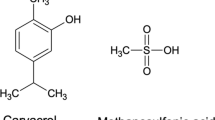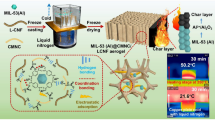Abstract
Wood is favored by furniture and decorative materials due to its beautiful color and texture, lightweight and high strength, but the thermal stability and flame retardants of wood have not been well solved. In this paper, metal salt-doped ammonium polyphosphate silicon gel (Cu, Mn/APP/Gel) was trapped in the wood cell wall and cell cavity by vacuum-pressure infusion method and vacuum drying method. Compared with unmodified wood, Cu, Mn/APP/Gel impregnated wood can rapidly enhance the flame retardant and smoke suppression capability of wood due to the catalysis of Cu2+ and Mn2+, and the total heat release rate, heat release rate peak value, mean heat release rate, smoke produce rate, total smoke release, CO and CO2 yield (YCO, YCO2) are obviously reduced. The electronic microscope picture of the burned carbon layer shows that the Cu, Mn/APP/Gel doped wood no longer has a clear and beautiful carbon layer formed by cell structure, but completely forms a whole. It is this dense and firm carbon layer structure that effectively inhibits the thermal decomposition of wood and has a role in flame retardant and smoke suppression. This study proposed an environment-friendly and green scheme for flame retardant modification of wood.














Similar content being viewed by others
References
Zehui J. Wood properties of the global important tree species. 2nd ed. Beijing: Science press; 2001.
Biguang Z. Research progress in wood science and technology. Beijing: China Environmental Press; 2004.
Agarwal C, Csoka L. Functionalization of wood/plant-based natural cellulose fibers with nanomaterials: a review. Tappi J. 2018;17(2):92–111.
Li-Jianzhang Z, Zhangde-Rong W. Research and application progress of wood modification in the world. Intl Wood Ind. 2002;03:17–9.
Lian-Bai G. Current status and application prospects of wood modification. China Wood Ind. 2012;26(03):1–6.
Teng T-J, Arip MNM, Sudesh K, et al. Conventional technology and nanotechnology in wood preservation: a review. BioResources. 2018;13(4):9220–52.
Lvyan F, et al. Research progress in sol–gel modification of wood. Polym Bull. 2013;12:31–7.
Favarim HR, Leite LO. Performance of ZnO nanoparticles for fire retardant and UV protection of pine wood. BioResources. 2018;13(3):6963–9.
Huangzhe J. Analysis on flame retardancy and surface micromorphology of wood of ancient architecture components modified by nano-sol-gel. Nanjing: Nanjing Forestry University; 2016. p. 2016.
Hung KC, Wu JH. Comparison of physical and thermal properties of various wood-inorganic composites (WICs) derived by the sol-gel process. Holzforschung. 2018;72(5):379–86.
Ning L. Prepare wood/inorganic materials by sol-gel process. Beijing: Beijing Forestry University; 2004.
Jianfeng H. Principle and Technology of Sol-Gel[M]. Beijing: Teaching Material Publishing Center of Chemical Industry Press; 2005.
Komarneni SSSPPP, et al. Sol-gel synthesis and processing[M]. USA: The American Ceramic Society; 1998.
Ogiso K. Wood-inorganic composites prepared by sol-gel process, 4: effects of chemical bonds between wood and inorganic substances on property enhancement. J Japan Wood Res Soc. 1994;40(10):1100–6.
Chaochao L. Study on the modification of Chinese fir by silica sol to enhance wood’s fir-resisting property[D]. ZheJiang: Zhejiang University; 2010.
Huang Suyong LK. China Fir/TiO2 composite prepared by using sol-gel method and its antibacterial property. China Forest Prod Ind. 2010;37(05):21–3.
Jiang Y-F, Fu-Xing CHU, Qin T-F. Element distribution inside silicon modified wood. China Wood Ind. 2013;27(01):21–3.
Lu Y, Feng M, Zhan H. Preparation of SiO2-wood composites by an ultrasonic-assisted sol-gel technique. Cellulose. 2014;21(6):4393–403.
Ye Qingqing LJ, Qian X, et al. Research on fire retardant performance of wood with the compound of potassium carbonate and SiO2 gels. New Build Mater. 2011;38(09):24–7.
Saka SSMTM. Wood-inorganic composites prepared by sol-gel processing 1: wood-inorganic composites with porous structure. J Japan Wood R Soc. 1992;38(11):1043–9.
Jiang-Xiao L. Application of the visual characteristics of Paulownia wood in furniture design. Packag Eng. 2009;30(08):109–110113.
Yuling D. Study on the modification of Chinese fir by silica sol to enhance wood’s fire-resisting property[D]. ChangSha: Central South of Forestry and Technology; 2016.
Hu Yunchu FS, et al. Preparation and combustion performance of Paulownia wood treated with APP/silica gel. J Build Mater. 2017;20(04):651–5.
Mahr MS, Hubert T, Sabel M, et al. Fire retardancy of sol-gel derived titania wood-inorganic composites. J Mater Sci. 2012;47(19):6849–61.
Acknowledgements
The work was financially supported by Natural Science Foundation of China (Grant No. 31670563) and the Open Fund Project for Innovation Platform of Biomass Composite Materials in Universities of Hunan Province.
Author information
Authors and Affiliations
Contributions
All authors contributed to the study conception and design. Material preparation, data collection and analysis were performed by LT, YW, YL and LY. The first draft of the manuscript was written by LT and all authors commented on previous versions of the manuscript. All authors read and approved the final manuscript. Conceptualization: LT, YW and LY; Methodology: LT, YW and YL; Formal analysis and investigation: LT and LY; Writing—original draft preparation: LT, YW and YL; Writing—review and editing: LT, LY, YH, YF and GY; Funding acquisition: LY and YH; Resources: LY and YH; Supervision: LY.
Corresponding authors
Additional information
Publisher's Note
Springer Nature remains neutral with regard to jurisdictional claims in published maps and institutional affiliations.
Rights and permissions
About this article
Cite this article
Tang, L., Wu, Y., Yuan, L. et al. The heat insulation and smoke suppression effect of M-Si-phosphocarbonaceous catalyzed by metal salt-doped APP silicon gel in situ build in wood. J Therm Anal Calorim 146, 2353–2364 (2021). https://doi.org/10.1007/s10973-020-10530-3
Received:
Accepted:
Published:
Issue Date:
DOI: https://doi.org/10.1007/s10973-020-10530-3




